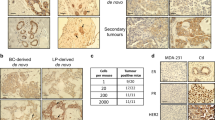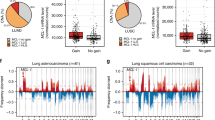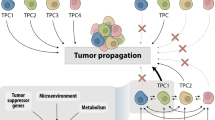Abstract
Although apoptosis can be induced by the enforced expression of exogenously introduced c-myc genes, it is not clear whether overexpression resulting from the amplification of the resident c-myc gene in tumor cells is sufficient to induce apoptosis. We have investigated the relationship between c-myc gene amplification and the propensity of tumor cells to undergo apoptosis, using the SW613-12A1 and SW613-B3 cell lines, which are representatives, respectively, of tumorigenic and non-tumorigenic clones isolated from the SW613-S human colon carcinoma cell line. Tumorigenic clones are characterized by a high level of amplification and expression of the c-myc gene, whereas cells of non-tumorigenic clones have a small number of copies and a lower level of expression of this gene. Analysis of c-myc mRNA level in cells cultured under low serum conditions indicated that the expression of the gene is tightly regulated by serum growth factors in non-tumorigenic B3 cells, whereas it is poorly regulated in tumorigenic 12A1 cells, the level of mRNAs remaining relatively high in serum-starved 12A1 cells. Under these conditions, 12A1 cells showed clear evidence of apoptosis, whereas B3 cells were completely refractory to the induction of apoptosis. Moreover, the study of cell lines derived from non-tumorigenic apoptosis-resistant clones following the introduction by transfection of exogenous c-myc gene copies showed that they have acquired an apoptosis-prone phenotype. Altogether, our results strongly suggest that deregulated c-myc expression due to high-level amplification confers an apoptosis-prone phenotype to tumor cells. The possible consequences of these observations for cancer therapy are discussed.
This is a preview of subscription content, access via your institution
Access options
Subscribe to this journal
Receive 50 print issues and online access
$259.00 per year
only $5.18 per issue
Buy this article
- Purchase on Springer Link
- Instant access to full article PDF
Prices may be subject to local taxes which are calculated during checkout






Similar content being viewed by others
Abbreviations
- BCIP:
-
5-bromochloro-3-indolyl phosphate
- DGGE:
-
denaturing gradient gel electrophoresis
- DMEM:
-
Dulbecco's modified Eagle medium
- NBT:
-
p-nitrotetrazolium blue
- PARP:
-
poly(ADP-ribose) polymerase
- PBS:
-
phosphate buffered saline
- SDS – PAGE:
-
sodium dodecyl sulphate-polyacrylamide gel electrophoresis
References
Alarcon RM, Rupnow BA, Graeber TG, Knox SJ and Giaccia AJ. . 1996 Cancer Res. 56: 4315–4319.
Amati B and Land H. . 1994 Curr. Opin. Genet. Dev. 4: 102–108.
Askew DS, Ashmun RA, Simmons BC and Cleveland JL. . 1991 Oncogene 6: 1915–1922.
Augenlicht LH, Wadler S, Corner G, Richards C, Ryan L, Multani AS, Pathak S, Benson A, Haller D and Heerdt BG. . 1997 Cancer Res. 57: 1769–1775.
Barbu V and Dautry F. . 1989 Nucleic. Acids Res. 17: 7115.
Bishop JM. . 1995 Genes & Dev. 9: 1309–1315.
Bissonnette RP, Echeverri F, Mahboubi A and Green DR. . 1992 Nature 359: 552–554.
Bracey TS, Miller JC, Preece A and Paraskeva C. . 1995 Oncogene 10: 2391–2396.
Brison O. . 1993 Biochim. Biophys. Acta 1155: 25–41.
Chinnaiyan AM, Orth K, O'Rourke K, Duan H, Poirier GG and Dixit VM. . 1996 J. Biol. Chem. 271: 4573–4576.
Darzynkiewicz Z, Bruno S, Del Bino G, Gorczyca W, Hotz MA, Lassota P and Traganos F. . 1992 Cytometry 13: 795–808.
Dautry F, Weil D, Yu J and Dautry-Varsat A. . 1988 J. Biol. Chem. 263: 17615–17620.
Davis AC, Wims M, Spotts GD, Hann SR and Bradley A. . 1993 Genes & Dev. 7: 671–682.
Dong J, Naito M and Tsuruo T. . 1997 Oncogene 15: 639–647.
El-Deiry WS. . 1997 Curr. Opin. Oncol. 9: 79–87.
Endicott JA and Ling V. . 1989 Annu. Rev. Biochem. 38: 137–171.
Erisman MD, Rothberg PG, Diehl RE, Morse CC, Spandorfer JM and Astrin SM. . 1985 Mol. Cell. Biol. 5: 1969–1976.
Evan GI and Littlewood TD. . 1993 Curr. Opin. Genet. Dev. 3: 44–49.
Evan GI, Wyllie AH, Gilbert CS, Littlewood TD, Land H, Brooks M, Waters CM, Penn LZ and Hancock DC. . 1992 Cell 69: 119–128.
Fanidi A, Harrington EA and Evan GI. . 1992 Nature 359: 554–556.
Fukasawa K, Wiener F, Vande Woude GF and Mai S. . 1997 Oncogene 15: 1295–1302.
Galdemard C, Brison O and Lavialle C. . 1995 Oncogene 10: 2331–2342.
Guano F, Bernardi R, Donzelli M, Prosperi E, Astaldi Ricotti G and Scovassi AI. . 1994 Cell Death Diff. 1: 101–107.
Hague A, Hicks DJ, Bracey TS and Paraskeva C. . 1997 Br. J. Cancer 75: 960–968.
Hague A, Manning AM, Hanlon KA, Huschtscha LI, Hart D and Paraskeva C. . 1993 Int. J. Cancer 55: 498–505.
Han J, Dionne CA, Kedersha NL and Goldmacher VS. . 1997 Cancer Res. 57: 176–182.
Harrington EA, Bennett MR, Fanidi A and Evan GI. . 1994a EMBO J. 13: 3286–3295.
Harrington EA, Fanidi A and Evan GI. . 1994b Curr. Opin. Genet. Dev. 4: 120–129.
Haupt Y, Rowan S and Oren M. . 1995 Oncogene 10: 1563–1571.
Hermeking H and Eick D. . 1994 Science 265: 2091–2093.
Hoffman B and Liebermann DA. . 1994 Oncogene 9: 1807–1812.
Hueber A-O, Zörnig M, Lyon D, Suda T, Nagata S and Evan GI. . 1997 Science 278: 1305–1309.
Kangas A, Nicholson DW and Hölttä E. . 1998 Oncogene 16: 387–398.
Lamarre D, Talbot B, de Murcia G, Laplante C, Leduc Y, Mazen A and Poirier GG. . 1988 Biochim. Biophys. Acta 950: 147–160.
Lamonerie T, Lavialle C, Haddada H and Brison O. . 1995 Int. J. Cancer 61: 587–592.
Lavialle C, Modjtahedi N, Cassingena R and Brison O. . 1988 Oncogene 3: 335–339.
Lavialle C, Modjtahedi N, Cassingena R and Brison O. . 1990 Oncogene 5: 245.
Lavialle C, Modjtahedi N, Lamonerie T, Frebourg T, Landin R-M, Fossar N, Lhomond G, Cassingena R and Brison O. . 1989 Anticancer Res. 9: 1265–1280.
Lazebnik YA, Kaufmann SH, Desnoyers S, Poirier GG and Earnshaw WC. . 1994 Nature 371: 346–347.
Levine AJ. . 1993 Annu. Rev. Biochem. 62: 623–651.
Lowe SW, Schmitt EM, Smith SW, Osborne BA and Jacks T. . 1993 Nature 362: 847–849.
Marcu KB, Bossone SA and Patel AJ. . 1992 Annu. Rev. Biochem. 61: 809–860.
Marx J. . 1993 Science 259: 760–761.
Modjtahedi N, Haddada H, Lamonerie T, Lazar E, Lavialle C and Brison O. . 1992 Int. J. Cancer 52: 483–490.
Modjtahedi N, Lavialle C, Poupon M-F, Landin R-M, Cassingena R, Monier R and Brison O. . 1985 Cancer Res. 45: 4372–4379.
Negri C, Bernardi R, Donzelli M and Scovassi AI. . 1995 Biochimie 77: 893–899.
Nigro JM, Baker SJ, Preisinger AC, Jessup JM, Hostetter R, Cleary K, Bigner SH, Davidson N, Baylin S, Devilee P, Glover T, Collins FS, Weston A, Modali R, Harris CC and Vogelstein B. . 1989 Nature 342: 705–708.
Packham G and Cleveland JL. . 1995 Biochim. Biophys. Acta 1242: 11–28.
Pellegata NS, Sessa F, Renault B, Bonato M, Leone BE, Solcia E and Ranzani GN. . 1994 Cancer Res. 54: 1556–1560.
Reed JC. . 1995 Curr. Opin. Oncol. 7: 541-–546.
Reed JC. . 1997 Nature 387: 773–776.
Renault B, van den Broek M, Fodde R, Wijnen J, Pellegata NS, Amadori D, Khan PM and Ranzani GN. . 1993 Cancer Res. 53: 2614–2617.
Rupnow BA, Alarcon RM, Giaccia AJ and Knox SJ. . 1998 Cell Death Diff. 5: 141–147.
Sakamuro D, Eviner V, Elliott KJ, Showe L, White E and Prendergast GC. . 1995 Oncogene 11: 2411–2418.
Sambrook J, Fritsch EF and Maniatis T. . (1989). Cold Spring Harbor Laboratory Press: New York.
Shah GM, Poirier D, Duchaine C, Brochu G, Desnoyers S, Lagueux J, Verreault A, Hoflack J-C, Kirkland JB and Poirier GG. . 1995 Anal. Biochem. 227: 1–13.
Shaw P, Bovey R, Tardy S, Sahli R, Sordat B and Costa J. . 1992 Proc. Natl. Acad. Sci. USA 89: 4495–4499.
Spencer CA and Groudine M. . 1991 Adv. Cancer Res. 56: 1–48.
Towbin H, Staehelin T and Gordon J. . 1979 Proc. Natl. Acad. Sci. USA 76: 4350–4354.
Vaux DL, Cory S and Adams J. . 1988 Nature 335: 440–442.
Wagner AJ, Kokontis JM and Hay N. . 1994 Genes & Dev. 8: 2817–2830.
Wagner AJ, Small MB and Hay N. . 1993 Mol. Cell. Biol. 13: 2432–2440.
Yonish-Rouach E, Resnitzky D, Lotem J, Sachs L, Kimchi A and Oren M. . 1991 Nature 352: 345–347.
Acknowledgements
We are greatly indebted to Dr G Poirier (Université Laval, Québec, Canada) for the monoclonal antibody C-2-10 and to Prof G Ranzani (IGM, Università di Pavia, Italy) for helpful discussions on p53 experiments. M Donzelli was supported by a fellowship from AIRC (Associazione Italiana per la Ricerca sul Cancro). C Negri and L Padovan are Telethon and Anna Villa Rusconi fellows, respectively. This work was supported in part by grants from the Association pour la Recherche sur le Cancer and from the Ligue Nationale contre le Cancer.
Author information
Authors and Affiliations
Rights and permissions
About this article
Cite this article
Donzelli, M., Bernardi, R., Negri, C. et al. Apoptosis-prone phenotype of human colon carcinoma cells with a high level amplification of the c-myc gene. Oncogene 18, 439–448 (1999). https://doi.org/10.1038/sj.onc.1202309
Received:
Revised:
Accepted:
Published:
Issue Date:
DOI: https://doi.org/10.1038/sj.onc.1202309
Keywords
This article is cited by
-
CIP2A is a predictor of survival and a novel therapeutic target in bladder urothelial cell carcinoma
Medical Oncology (2013)
-
Multiple effects of the Na+/H+ antiporter inhibitor HMA on cancer cells
Apoptosis (2013)
-
Enzyme-assisted photosensitization activates different apoptotic pathways in Rose Bengal acetate treated HeLa cells
Histochemistry and Cell Biology (2009)
-
DADLE induces a reversible hibernation-like state in HeLa cells
Histochemistry and Cell Biology (2006)
-
DNA ligase I is dephosphorylated during the execution step of etoposide-induced apoptosis
Cell Death & Differentiation (2002)



